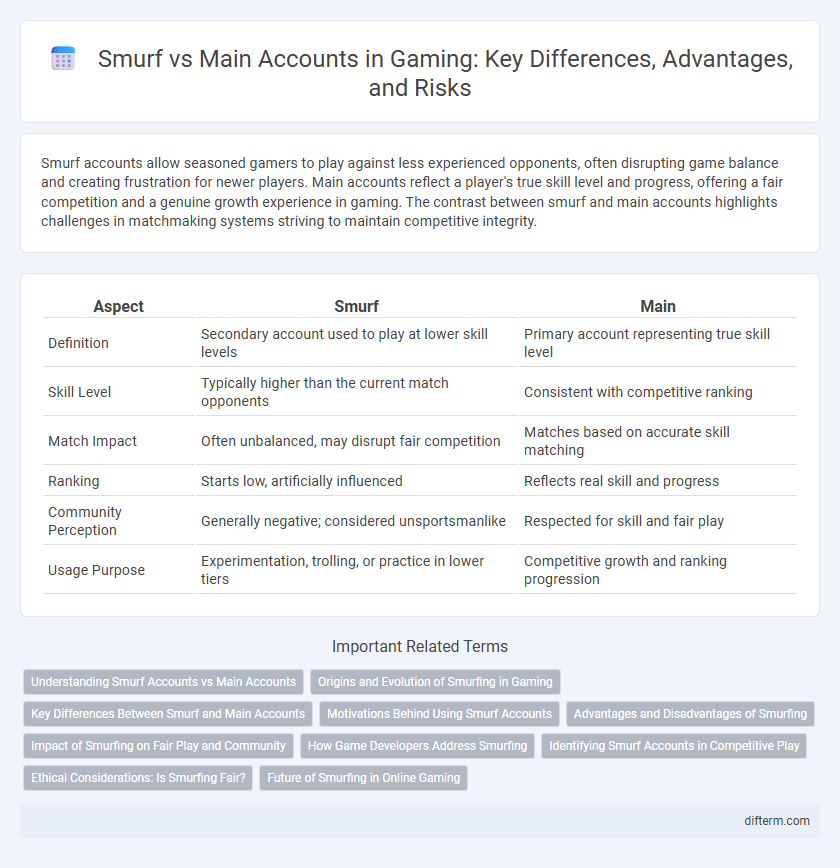Smurf accounts allow seasoned gamers to play against less experienced opponents, often disrupting game balance and creating frustration for newer players. Main accounts reflect a player's true skill level and progress, offering a fair competition and a genuine growth experience in gaming. The contrast between smurf and main accounts highlights challenges in matchmaking systems striving to maintain competitive integrity.
Table of Comparison
| Aspect | Smurf | Main |
|---|---|---|
| Definition | Secondary account used to play at lower skill levels | Primary account representing true skill level |
| Skill Level | Typically higher than the current match opponents | Consistent with competitive ranking |
| Match Impact | Often unbalanced, may disrupt fair competition | Matches based on accurate skill matching |
| Ranking | Starts low, artificially influenced | Reflects real skill and progress |
| Community Perception | Generally negative; considered unsportsmanlike | Respected for skill and fair play |
| Usage Purpose | Experimentation, trolling, or practice in lower tiers | Competitive growth and ranking progression |
Understanding Smurf Accounts vs Main Accounts
Smurf accounts are secondary player profiles created to play at a lower skill level, often by experienced gamers seeking easier matches or to practice new strategies. Main accounts represent a player's primary gaming identity, reflecting their true skill level, ranking, and progression within the game. Understanding the distinction between smurf and main accounts is essential for analyzing player behavior, matchmaking fairness, and competitive balance in online gaming communities.
Origins and Evolution of Smurfing in Gaming
Smurfing in gaming originated in the late 1990s when skilled players created alternate accounts to disguise their expertise and play against less experienced opponents. This practice evolved with the rise of competitive multiplayer games like StarCraft and Counter-Strike, where ranking systems incentivized players to mask their true skill levels. Over time, smurfing has become a widespread phenomenon, prompting developers to implement measures to detect and mitigate its impact on fair matchmaking.
Key Differences Between Smurf and Main Accounts
Smurf accounts are secondary accounts typically used by experienced gamers to compete at lower skill levels, while main accounts represent a player's primary identity with their true skill rating. Key differences include smurf accounts often having fewer ranked matches, lower win rates in higher tiers, and minimal unlocked content compared to mains. Mains generally have higher in-game progression, authentic matchmaking history, and established reputations within the gaming community.
Motivations Behind Using Smurf Accounts
Smurf accounts are created by experienced gamers to compete against lower-skilled players, often driven by the desire to dominate easily or experiment with new strategies without risking their main account's ranking. These accounts offer a way to avoid pressure and expectations tied to their main profile, allowing for more relaxed gameplay and skill refinement. Motivations also include helping friends improve or testing unfamiliar roles and champions without impacting their primary competitive standing.
Advantages and Disadvantages of Smurfing
Smurfing in gaming offers the advantage of allowing experienced players to dominate lower-ranked matches, providing a quick and often satisfying way to practice skills or experiment with new strategies. However, it creates an unbalanced playing field, leading to frustration and reduced enjoyment for genuine lower-ranked players who face opponents with significantly higher skill levels. This practice disrupts matchmaking integrity and can result in penalties or bans from game developers aiming to maintain fair competition.
Impact of Smurfing on Fair Play and Community
Smurfing disrupts fair play by creating unbalanced matches where inexperienced players face opponents with superior skills, leading to frustration and reduced enjoyment. This practice undermines the competitive integrity of games, as smurfs skew ranking systems and diminish the relevance of player statistics. The gaming community often experiences increased toxicity and decreased retention rates due to the negative experiences caused by smurf accounts.
How Game Developers Address Smurfing
Game developers implement advanced matchmaking algorithms and account verification systems to minimize the impact of smurfing on player experience. They often use machine learning to detect abnormal gameplay patterns indicative of smurf accounts and enforce penalties such as temporary bans or rank adjustments. Continuous updates to anti-smurfing measures are crucial for maintaining fair competition and balancing skill-based matchmaking in online multiplayer games.
Identifying Smurf Accounts in Competitive Play
Smurf accounts in competitive gaming are identified through discrepancies in skill level and performance metrics compared to their account history. Indicators include unusually high win rates, rapid ranking climbs, and consistent execution of advanced strategies typically unseen at lower tiers. Monitoring gameplay data such as kill/death ratios, reaction times, and map control efficiency helps distinguish smurf accounts from genuine novice players.
Ethical Considerations: Is Smurfing Fair?
Smurfing raises ethical concerns as it disrupts fair competition by allowing experienced players to dominate less skilled opponents, undermining the integrity of matchmaking systems. This practice can discourage new players, distort ranking accuracy, and diminish overall player satisfaction in gaming communities. Maintaining fair play requires developers to implement stricter detection and prevention measures against smurf accounts.
Future of Smurfing in Online Gaming
Smurfing in online gaming involves experienced players creating secondary accounts to compete against less skilled opponents, raising ongoing debates about fairness and matchmaking balance. Advances in artificial intelligence and sophisticated matchmaking algorithms are expected to detect and mitigate smurfing more effectively, promoting equitable gameplay environments. As anti-smurfing technologies evolve, the future of online gaming may see reduced smurfing incidents, fostering more competitive and enjoyable experiences for all players.
smurf vs main Infographic

 difterm.com
difterm.com